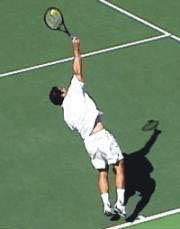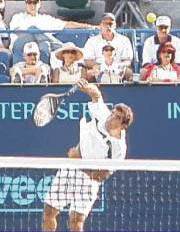<% ns_puts [mkm_getnavbar] %>

Advanced Tennis: Sampras Serve
The Racquet Path
by John Yandell
Page 2
|
Key Position 2: Contact Point
The second factor in maximizing the acceleration of
the racket head is achieving full arm extension, and also, full arm
rotation at the contact point. At
contact, Pete’s arm is completely straight.
When viewed from in front or behind, the arm is pointing almost
directly upward, literally at 90 degrees to the court surface. From the
side view we can see his arm is also tilted slightly forward from the
shoulder. This is a function of the ball toss and places the contact point
slightly in front of the plane of his body.
Note the arm, although straight and quite extended, is raised only slightly above the level of his shoulder. This is due primarily to Pete’s unique body position - or rather the angle of his entire torso and body in relation to the court, as we’ll explore in a later article.
The movement of the arm from the drop position to the
contact involves two components. First, a triceps extension.
Second, a palm, forearm, and upper arm rotation.
 |
 |
Pete’s tremendous extension at contact. The arm is straight, on a perpendicular with the court and tilted slightly forward to make contact in front of the body. |
|
“Triceps extension” is a technical way of saying,
as the racket moves up to the contact, the arm straightens out from the
elbow. The start of this arm
extension takes the racket roughly halfway to the ball.
During the second half of the movement from the drop to the contact point, the triceps extension continues until the arm is straight. But this is now combined with the second movement element, hand and arm rotation. This rotation begins when the racket head has traveled roughly halfway upward. Essentially, the arm rotates from left to right about 90 degrees from its position at the racket drop to its position at contact. This rotating motion includes the palm of the hand, the forearm, and the upper arm.
 |
 |
The
arm starts to straighten through a triceps extension, taking the racket
halfway to the ball.
|
|
A fellow teaching pro has described this complex
motion vividly and wonderfully as giving the ball a “high five.” From
the racket drop position, Pete moves the racket head to the contact
exactly as if he was delivering a high five with the palm of his hand. The result is solid, square contact, and tremendous speed and spin.
Pete serves with a classic continental grip.
“High fiving” the ball with this grip means the racket head
will automatically strike the ball at an angle, traveling on a diagonal
from left to right. The right edge
of the racket leading the motion, staying slightly ahead of the left.
This produces spin automatically.
Using the palm of the hand Pete can approach the ball at slightly different diagonals, and therefore vary the amount and type of spin, all using an identical ball toss. This is something we will also examine in detail in a subsequent article.
|
Notice that in the description of this critical phase
in the service motion there is absolutely no mention of the word
“wrist.” One of the great clichés
in tennis teaching regarding the serve, is that the “wrist snap” is
the key to power and spin. If we
look at Pete’s motion in high speed video (or that of most any other top
player), we can see this is absolutely untrue.
At best there may be some slight flexion of the wrist from left to
right. But the wrist never snaps or breaks forward.
Long after the ball is gone, the wrist naturally releases and falls
towards the court, causing the racket head to drop slightly down as well,
but this has nothing to do with the biomechanics of the hit itself.
Many players try for years to improve their serves by increasing “wrist snap.” If you have been laboring to improve your serve focusing on the wrist, it’s time to try something that actually reflects the bio-mechanics of the top servers. The result will probably amaze you.
Page 1 - Page 3
To view the complete ProStrokes Gallery of digitally mastered Pete Sampras serves, click here.
Your comments are welcome. Let us know what you about think John Yandell's article by emailing us here at TennisONE.
Last Updated 7/1/00. To contact us, please email to: webmaster@tennisone.com
TennisONE is a registered trademark of TennisONE and SportsWeb ONE; Copyright 1995. All rights reserved.




